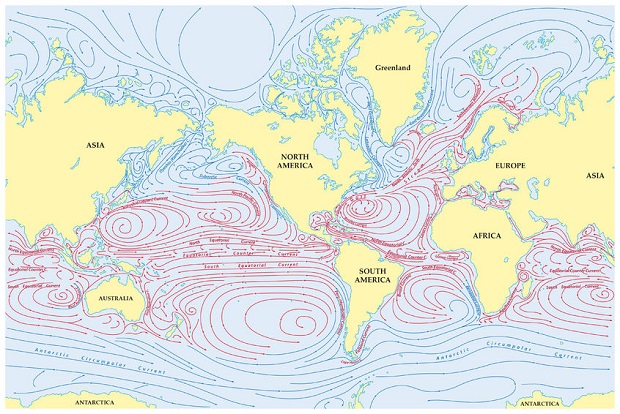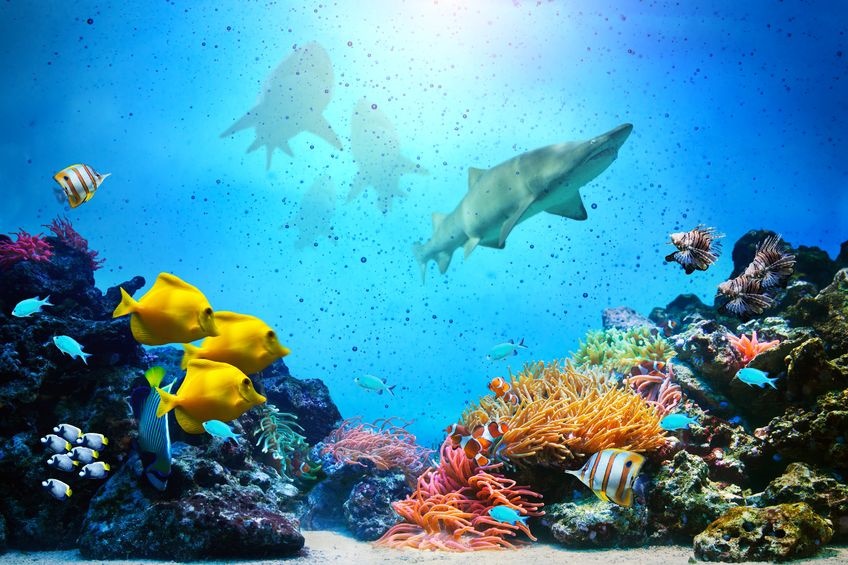
There are two different types of ocean currents: surface circulation, or surface currents, and thermohaline circulation, also known as deep water currents. Different forces affect and control these two currents, and they play a pivotal role in distributing various natural resources. One of the most important functions of ocean currents, particularly deep water currents, is distributing heat from warmer regions to cooler ones and vice versa.
Surface Circulation
Surface currents make up just one-tenth of all the water in the ocean. Surface currents are driven primarily by the wind. However, several other factors are in play that determine the direction and speed of the current. In particular, ocean currents are affected by heat from the sun and by gravitational pull. Currents are also affected by geographic features on the sea floor and along the coast.
The directional flow of surface circulation is heavily influenced by the Coriolis Effect. Earth rotates on its axis, creating a horizontal pull that forces the currents in a particular direction. North of the equator, currents flow in a circular pattern towards the right. In the southern hemisphere, currents flow in the opposite direction, to the left.
Water expands when heated, causing the water levels in the equator to be marginally higher than at other latitudes. Winds then blow on the ocean’s surface, and the water moves, causing friction between the wind and the water.
As winds act on the surface of the ocean, water tends to pile or pool. Gravity then acts on the forces of the water, driving them away from the pool. The Coriolis Effect directs the water in a circular motion around the pool. These large pools are known as gyres. There are prominent gyres in each of the world’s oceans and both hemispheres.
Perhaps the best-known of these gyres is the Gulf Stream in the mid-Atlantic. The Gulf Stream channels warmer water from the trade winds at the equator to the shores of England, Spain, and much of the European mainland. The Gulf Stream keeps the temperature of much of Europe warmer than it normally would be that far north and is responsible for the relatively mild climates of England, France, and Germany.
Thermohaline Circulation
Thermohaline circulation takes its name from two Latin roots. Thermo- means temperature, and -haline means salt. Thermohaline currents are driven by the differences in water temperature and salinity, both of which affect the density of the deep-water oceans.
While surface currents are driven by the wind and flow in predictable circular patterns, deep water currents take place far below the surface of the water, where the light of the sun does not penetrate.
Thermohaline circulation is often referred to as the global conveyor belt. As water evaporates or freezes, particularly in the oceans nearest the poles, sea salt remains. This further salinates the ocean water and the heavier, saltier water sinks to the ocean basins. Differences in water temperature and salinity drive the ocean currents north and south.
While surface currents obviously affect the climate, thermohaline currents also affect global temperatures, keeping the poles colder and moving warmer waters to the equatorial regions. They are also responsible for distributing nutrients and other bio-matter across the oceans. Thus ocean currents play a tremendous role in maintaining the health of the oceanic ecosystem.
Resources
- Encyclopædia Britannica – “Ocean Current.“
- National Oceanic and Atmospheric Administration (NOAA) – “Ocean Currents.”
- Stott, Dr. Lowell D. “Ocean Currents and Climate.” USC University of Southern California-Department of Earth Sciences.


